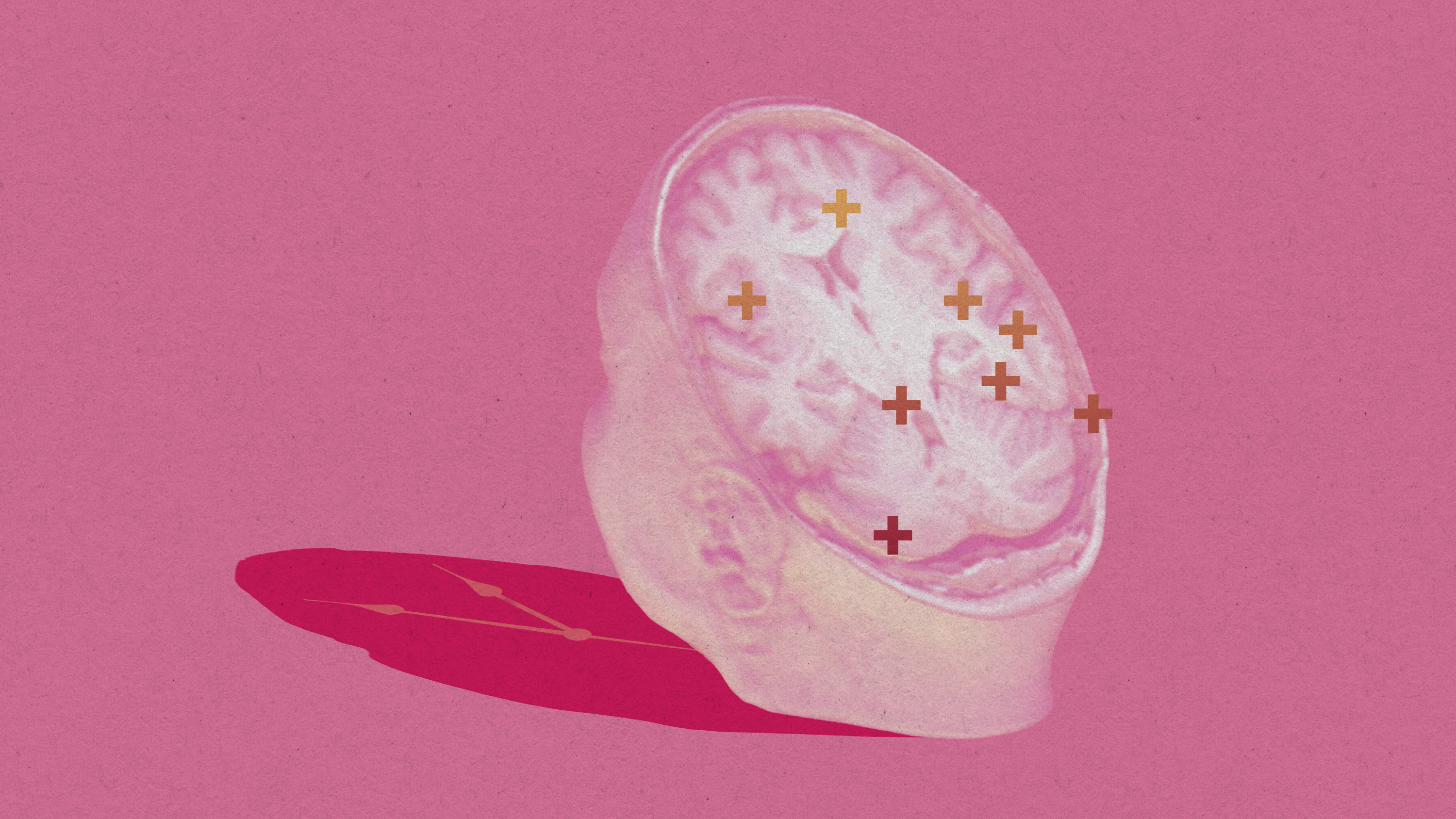How it feels to have a life-changing brain implant removed
Ian Burkhart’s brain implant let him use his hand for the first time in years. Then it was taken out.

This article is from The Checkup, MIT Technology Review's weekly biotech newsletter. To receive it in your inbox every Thursday, sign up here.
Ian Burkhart sustained a severe spinal cord injury while he was on vacation at 19 years old. “It left me as a quadriplegic,” he says. “I had a little bit of movement in my arms, but nothing in my hands.” He wanted something that could give him more independence. And that’s how he came across a clinical trial for a brain implant that would change his life.
Experimental brain-computer interfaces are being trialed to help treat paralysis and epilepsy, among other things. They can transform a person’s health, independence, and very sense of self. So if a company or research team runs out of money and wants to remove the implant, it can have devastating consequences for the recipient.
Burkhart's device was implanted in his brain around nine years ago, a few years after he was left unable to move his limbs following a diving accident. He volunteered to trial the device, which enabled him to move his hand and fingers. But it had to be removed seven and a half years later.
His particular implant was a small set of 100 electrodes, carefully inserted into a part of the brain that helps control movement. It worked by recording brain activity and sending these recordings to a computer, where they were processed using an algorithm. This was connected to a sleeve of electrodes worn on the arm. The idea was to translate thoughts of movement into electrical signals that would trigger movement.
Burkhart was the first to receive the implant, in 2014; he was 24 years old. Once he had recovered from the surgery, he began a training program to learn how to use it. Three times a week for around a year and a half, he visited a lab where the implant could be connected to a computer via a cable leading out of his head.
“It worked really well,” says Burkhart. “We started off just being able to open and close my hand, but after some time we were able to do individual finger movements.” He was eventually able to combine movements and control his grip strength. He was even able to play Guitar Hero.
“There was a lot that I was able to do, which was exciting,” he says. “But it was also still limited.” Not only was he only able to use the device in the lab, but he could only perform lab-based tasks. “Any of the activities we would do would be simplified,” he says.
For example, he could pour a bottle out, but it was only a bottle of beads, because the researchers didn’t want liquids around the electrical equipment. “It was kind of a bummer it wasn’t changing everything in my life, because I had seen how beneficial it could be,” he says.
At any rate, the device worked so well that the team extended the trial. Burkhart was initially meant to have the implant in place for 12 to 18 months, he says. “But everything was really successful … so we were able to continue on for quite a while after that.” The trial was extended on an annual basis, and Burkhart continued to visit the lab twice a week.
The device changed his life. “It definitely gave me a lot of hope for the future,” he says.
But there was bad news ahead. “It was probably around the five-year mark that we started running into some issues with funding,” he says. When the team did manage to secure funding, it was only for six to eight months. At one point, Burkhart says, he was told to have the implant removed, but assured that he could have it put back in once funding had come through.
“That’s not the way to handle it,” he says. “It’s a big risk to have the device removed, and then to put one back in right away.”
In 2021, he started developing an infection at the point where the cable led into his scalp. “That was the final nail in the coffin,” he says. He agreed to have the device removed in August of 2021 and has been without it since.
Having the implant removed was difficult, he tells me. “When I first had my spinal cord injury, everyone said: ‘You’re never going to be able to move anything from your shoulders down again,’” he says. “I was able to restore that function, and then lose it again. That was really tough.”
I spoke to a neurologist involved in clinical trials for brain-computer interfaces, who told me that informed consent is vital—trial volunteers need to know exactly what’s going to happen. But it’s not that simple, as Burkhart’s experience makes clear. “I knew the device was going to have to come out at some point,” Burkhart says. “But I didn’t know what it was going to feel like.”
Today, Burkhart is optimistic. And busy. He runs his own foundation, which provides support for people with spinal cord injuries. He consults for medical device manufacturers and works with an organization aiming to ensure that relevant medical research incorporates the voices and experiences of those with spinal cord injuries. And he and others who have volunteered in similar trials have formed the BCI Pioneers Coalition. Members work with companies developing devices and advise on their design.
Burkhart and his colleagues also advocate for the technology at conferences—“to get people excited about not just the science fiction aspect of what’s possible, but about the reality of what’s possible for … individuals with disabilities,” he says.
The BCI Pioneers Coalition is advocating for companies to be required to set up some sort of fund to support and care for trial volunteers when clinical trials go wrong or come to an end.
After all he’s been through, Burkhart says he would do it all again. “I definitely look forward to having another type of device implanted at some point in the future,” he says. “I’m really passionate about seeing this type of technology progress and get to the point where people can use it in their day-to-day life.”
Read more from Tech Review's archive
Nathan Copeland has a similar brain implant, and describes himself as a cyborg. He told my colleague Antonio Regalado that if he had a wireless device implanted, he would probably use it to play video games.
Last year, a completely paralyzed man used a brain implant to communicate entire sentences. He requested soup and beer and asked to play games with his son, as I reported last March.
And a woman with the motor neuron disease ALS was able to type her thoughts at a record-breaking rate of 62 words per minute, as Antonio reported earlier this year.
Others are using brain implants in slightly different ways—to understand and treat disorders like depression. One man I spoke to last year told me this approach saved his life.
Brain implants might be able to improve memory in people with brain damage. That was the preliminary finding of researchers who have developed what they call a memory prosthesis, as I reported last year.
From around the web
Gene therapies can be eye-wateringly expensive. The most expensive drug of 2023 is a treatment for hemophilia B, with a $3.5 million price tag. Here are the other most expensive drugs in the US in 2023. (FiercePharma)
A novel class of injected weight-loss drugs have made a big splash in recent months. Now an oral version of semaglutide, the drug marketed as Ozempic and Wegovy, appears to have comparable results. People who took a daily tablet lost 15% of their body weight over 17 months, according to drug manufacturer Novo Nordisk. (STAT)
Curiously, people who are already taking Ozempic injections say they have also stopped drinking, shopping, smoking, and nail-biting. Did scientists accidentally create an anti-addiction drug? (The Atlantic)
Ever had a lightbulb moment? A pair of researchers reckon they’ve found a pattern of brain activity associated with what they call “the Eureka effect,” and that it requires the cooperation of brain regions involved in memory, creative thinking, and the control of attention. (Cerebral Cortex)
Millionaire tech entrepreneur Bryan Johnson is taking part in an intergenerational blood swap with his son and father in an attempt to keep the older men young. Johnson is already spending millions on various treatments to try to slow or even reverse his rate of aging. (Bloomberg)
Deep Dive
Biotechnology and health

This researcher wants to replace your brain, little by little
The US government just hired a researcher who thinks we can beat aging with fresh cloned bodies and brain updates.

Aging hits us in our 40s and 60s. But well-being doesn’t have to fall off a cliff.
Lifestyle changes could counter some of the deterioration.

Beyond gene-edited babies: the possible paths for tinkering with human evolution
CRISPR will get easier and easier to administer. What does that mean for the future of our species?

A new law in California protects consumers’ brain data. Some think it doesn’t go far enough.
Tech companies collect brain data that could be used to infer our thoughts—so it’s vital we get legal protections right.
Stay connected
Get the latest updates from
MIT Technology Review
Discover special offers, top stories, upcoming events, and more.